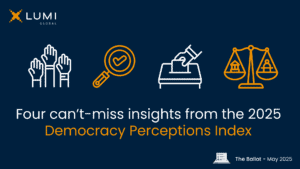“Democracy” is not a particularly new concept – in fact, the idea of “people power” is arguably as old as civilization itself. However, that doesn’t mean our idea of “democracy” has always been the same throughout history. In this piece, we will take a look at important points throughout history which contributed to how we perceive and practice democracy today.
From the People on Up
To break the idea of “democracy” down to its core, one need look no further than the ancient Greeks, who coined the word “dēmokratia” to describe a system where the people (dēmos) have the power to rule (kratos). While we will cover how ancient Greeks perceived and practiced democracy in more detail below, it might help to apply a more modern framework to “democracy” so we may understand its core tenets.
As put by American political scientist Robert Dahl in his 1998 work On Democracy, a democracy is something which “provides opportunities for:”
- Effective participation
- Equality in voting
- Gaining enlightened understanding
- Exercising final control over the agenda
- Inclusion of adults
What we will find in the history of democracy is not only the fact that some of these criteria were not met by systems which some consider to be “democratic,” but also that how these criteria were (and are) interpreted and put into practice has evolved. To give a simple example, while many early democratic systems were direct in nature, meaning citizens debated and passed laws themselves, we now recognize that a representative democracy in which citizens do not directly legislate but freely elect others to represent their interests is also a form of democracy.
Keeping this in mind, we now turn to taking a closer look at several events, movements, and institutions which each contributed in their own way to how we see and understand democracy today.
Turning Point #1: Athenian Democracy (500-300 BCE)
Although there is evidence of governance systems which could be described as “democratic” from indigenous cultures dating back millenia, we begin our foray into democracy by taking a closer look at the civilization whose language gave us the modern term “democracy”: Athens, Greece. Treated as a classic example of institutionalized direct democracy due to its Ecclesia (People’s Assembly) of 6,000 open to all citizens, Athenian democracy could be said to have met up to four of the criteria Dahl defined above since it provided opportunities for effective participation, control over the agenda, gaining of understanding via debate, and equality in voting.
The Ecclesia was certainly the most prominent democratic institution of ancient Athens, but Athenian government institutions also included the Council of 500, the People’s Court, and Magistracies. Interestingly, aside from the 100 top magistracies, members of these bodies were chosen by a method called sortition (also called “lot”), or a random drawing of volunteers, instead of elections. The reasoning for this was summarized by Aristotle, who stated that “it is considered democratic that offices should be filled by lot, and oligarchic that they should be elective.” This does not mean that he and other Greek practitioners of democracy believed that only a random selection of citizens to fill posts was democratic; rather, they believed that it was necessary to employ both systems as a way to both legislate effectively while still involving average citizens.
Turning Point #2: The Roman Republic (509-27 BCE)
At around the same time Athens was experimenting with its version of democracy, the Roman Republic to its west made its contribution to the development of democracy largely through its consistent use of elections and the recognition of popular sovereignty (i.e. rule by the people). The Roman constitution itself was “mixed” due to having monarchical, aristocratic, and democratic elements. However, the omnipresence of elections in society at local levels while maintaining an unprecedented level of stability for centuries led to the Roman Republic being an inspiration for later systems which we would deem representative democracies.
Officials in the Roman Republic, via its system of organizing citizens into local assemblies termed comitia as a means of gaining citizen approval, set out to prove that “the role of the people as the source of public legitimacy was undisputed.” Although there is some disagreement about whether the Republic itself, with its unelected Senate and the complete control elected magistrates wielded over the comitia, was actually a “democracy,” the Republic nonetheless employed several structures which contributed to the development of representative democracy later on.
Turning Point #3: The Things of Northern Europe (early to mid CE, 100-1100 CE)
Ancient Greece and Rome may have provided examples of local, often direct, democratic government, but, as asserted by Robert Dahl, the “combination” of an elected national parliament along with subordinate local councils was something which grew out of local assemblies, in particular those in Scandinavia. These assemblies, called “things,” were open meetings in which free men could decide on laws, settle conflicts, or just trade. These assemblies were a chance for “disputes to be settled in a neutral forum” instead of by violence, now a key tenet of democratic governance.
As part of Viking culture, things made their way across northern Europe and gradually became formal institutions rather than occasional gatherings, with the best example being Iceland’s Althing, established as a thing in 930 CE and serving today as the national parliament. Today, the word “thing” survives in other Nordic countries as well as a term for their parliaments, including Denmark (Folketing), Norway (Storting), and the Faroes (Løgting). Also, as one might guess, these assemblies are also the origin of the modern English word “thing.”
Towards Electoral Democracy
Turning Point #4: The Revival of Republicanism (16th-18th Centuries)
Republicanism, the idea that political power rests with citizens and their representatives rather than a monarch, was something which set the Roman Republic apart. However, it was not until well into the second millennium CE that republicanism came back into prominence, such as via the installation of Oliver Cromwell as Lord Protector of Great Britain following the defeat of the monarchy there in the English Civil War.
Of course, as with Rome, the amount of “democracy” in these republics varied, with some such as Venice and Florence maintaining legislative bodies where rulers were selected by sortition but results being largely biased towards elite families, while others such as the Dutch Republic and Great Britain were highly religious in nature and made little room for citizen participation. Regardless, the republics’ contribution to democracy going forward was helping to speed up the transition of average people from the role of subjects who had no sovereignty of their own under a monarch to citizens who (theoretically) held all political power.
Turning Point #5: The Enlightenment (17th-19th Centuries CE)
Although previous constitutions and institutions proved to be useful models for later democratic governments, ideas mattered as well in forming our perception of democracy today. During the period known as The Enlightenment in Europe, intellectuals grappled with ideas relating to governance. Notably, the liberal part of “liberal democracy” came into being during this time thanks to philosophers such as John Locke, Thomas Hobbes, and Jean-Jacques Rousseau, each of whom emphasized that legitimate governments must have the consent of citizens to rule and that citizens themselves, while accepting state authority, also possessed rights which a government could not violate.
At this time, intellectuals also revisited the Athenian idea of selecting representatives by sortition, with Montesquieu arguing that “suffrage by lot is natural to democracy, as that by choice [elections] is to aristocracy” and Rousseau believing that election was best suited for posts requiring “special talents” like the military and sortition for all other positions. As with the Greeks before them, they generally perceived a functional democratic government as having both items complementing one another.
Turning Point #6: The American and French Revolutions (18th -19th Centuries CE)
The American and French revolutions of the late 1700s served as critical junctures in how democracy is perceived for several reasons. First, a critical part of the post-revolution constitutions of each state included some sort of charter of rights for all citizens (the Bill of Rights in the US and the Declaration of the Rights of Man and of the Citizen in France), making the protection of citizen rights a democratic state’s responsibility. Second, new republics were created in which popular sovereignty was written into the new constitutions, guaranteeing the position of the citizens as “the sovereign” which should hold political power.
The third key development in this era was the decision to use elections as the only way of electing representatives. Taking inspiration from Rome, officials in both the US and France were skeptical of any group, average citizens included, of having too much power and thus decided to create a system in which a figure similar to a monarch (a president) would wield power while an unelected body (the US Senate) reserved for prominent citizens would provide an effective check against the elected legislature. As such, with little chance for citizens to be selected to serve in legislatures, elections became the cornerstone of what we now call “representative democracy.”
Turning Point #7: Universal Suffrage (20th Century CE)
The last and most elusive of Dahl’s criteria for a democracy up to this point, the “inclusion of adults” regardless of sex, religion, or ethnicity, was not achieved in earnest until the 20th century. Up until this point, progress had been made, albeit piecemeal: voting rights were first only afforded to”free men,” then gradually men of a certain background, then truly all men, and then finally women (although some countries did not necessarily follow this order).
Now considered a cornerstone of any democracy today, universal suffrage would certainly have been considered a radical idea by many of the key players in the previous turning points. Yet, as we have demonstrated, our perception of democracy has evolved over time, often for the better, and having as many citizens as possible make their voices heard can only improve the quality of democratic institutions, debate, and policies.
Turning Another Corner?
As we, along with others invested in supporting democracy, have been stating for years, democracy is in decline around the world. Since we cover the issue in more detail in posts such as this, we will refrain from repeating ourselves here. However, we would like to conclude this article with some food for thought for readers. Seeing as how many of these turning points altered how we both perceive and practice democracy, even sometimes upending previous systems altogether, will we perhaps be facing another turning point in the near future which will fundamentally alter how we think about democracy?
One option could be liquid democracy, a blended system of direct and representative democracy in which citizens may either take part in political decision making themselves or send others in their place. It has already been attempted on smaller scales in political parties and regions, and it is perhaps the most promising option which can be carried out digitally (such as through the free platform LiquidFeedback).
Another institution which is not new but is receiving renewed attention is one we have mentioned previously: sortition. Nowadays, random selection of citizens takes place in numerous democracies as part of citizens’ assemblies, which may be convened to provide advice to elected bodies, determine budgets, or even craft legislation themselves. Some political scientists advocate for expanding the role of sortition in democratic governments as a way to more actively involve citizens in deliberation and policy-making.
Irrespective of what the next major democratic event or innovation might be, we would like to make one final point. As with much in life, “democracy” is not a single destination we reach and then establish a culture; it is an ongoing journey. “Democracy” has been interpreted differently throughout history, and will likely continue to be into the future, but we must never abandon our drive to tweak and improve institutions so they stay as close as possible to the democratic ideal of “by the people, for the people.”


